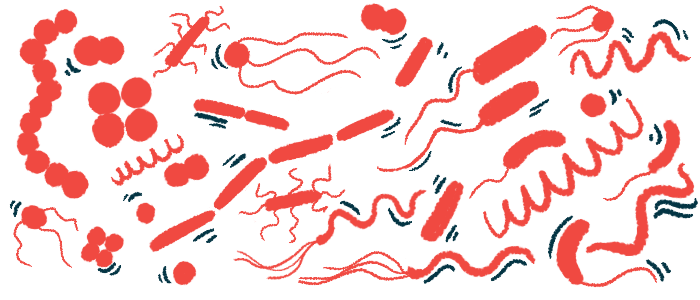CF lung inflammation persists after treatment due to stubborn bacteria
Study findings challenge idea that damage to respiratory organ is key factor
Written by |

Persistent Pseudomonas aeruginosa infection in people with cystic fibrosis (CF) who have received treatment with Trikafta (elexacaftor/tezacaftor/ivacaftor) seems to be a main driver of lung inflammation, a new study found. Trikafta is a highly effective CFTR modulator.
Researchers also observed an “all-or-none” pattern in infection clearance in most patients. When a person cleared P. aeruginosa after treatment, all lung regions were clear from infection, even those with severe damage. In turn, patients who did not clear the infection had P. aeruginosa and widespread inflammation in all lung regions, including those with very little damage.
The findings challenge the hypothesis that mildly diseased lung areas would clear infection and inflammation after Trikafta treatment, while severely damaged lung regions would not.
The study, “Pseudomonas infections persisting after CFTR modulators are widespread throughout the lungs and drive lung inflammation,” was published in the journal Cell Host & Microbe.
Modulators ‘have really improved people’s quality of life’
CF is characterized by the buildup of thick and sticky mucus in the lungs and other key organs. In the lungs, this mucus offers a fertile ground for bacteria and other microbes, leading to airway infections that cause inflammation and lung damage.
Recent advancements in CF treatment, particularly the approval of the highly effective CFTR modulator Trikafta, have substantially changed the outlook for people living with CF. However, many patients continue to experience persistent lung infections even after treatment. P. aeruginosa is a particular bacteria that is common in CF and is associated with poor clinical outcomes.
“Modulators are amazing new treatments that have really improved people’s quality of life,” Samantha Durfey, a former postdoctoral scholar at the University of Washington School of Medicine and the study’s first author, said in a university press release. “However, infections manage to stick around, even with the best modulator, and we need to understand why.”
The current hypothesis is that areas of significant lung damage are a key factor in leading lung infections to persist after treatment. Researchers believe that mildly affected areas are amenable to treatment, while severely diseased segments will not respond.
“A leading idea in the field is that patients remain infected because highly damaged lung regions can’t clear the infection, similar to how damaged tissues in wounds get infected,” said study author Sid Kapnadak, MD, a pulmonologist at the University of Washington School of Medicine. “If a similar process is responsible for persistent CF lung infections, research can focus on these areas.”
Five lung regions sampled from each CF patient
To test this hypothesis, the researchers used advanced bronchoscopy — where a thin tube called a bronchoscope is inserted through the nose or mouth, then down the throat and into the lungs — to collect lung samples representing varying degrees of damage, infection, and inflammation.
The study included nine CF patients with a chronic P. aeruginosa lung infection alone or P. aeruginosa and Staphylococcus aureus. The team sampled five lung regions from each patient and each region was assessed before treatment and after 1.5 years of Trikafta. At both time points, high-resolution imaging was also conducted to measure the extent of structural lung damage in each region.
At first, the team confirmed there was a large variation within the lungs regarding damage, inflammation, bacteria content, and mucus concentration. In each region, these parameters correlated well with each other, with a person with more damage generally showing more mucus accumulation, a higher bacterial content, and more inflammation.
But “the values of these parameters in lung segments were largely independent of other segments in the same lung,” the team wrote, highlighting the heterogeneity, or diversity, between different lung segments in a single patient.
Analysis reveals ‘all-or-none’ pattern
After 1.5 years of Trikafta, there were significant improvements across all parameters evaluated and 40% of lung segments became negative for P. aeruginosa post-treatment.
However, the analysis revealed an “all-or-none” pattern, in which either all or none of the lung regions in a given participant cleared the lung infection following treatment.
In three out of nine participants, all the 15 lung areas sampled became clear of bacteria, and 27% of these were deemed to have the worst overall disease severity. In the six patients with persistent infections, all regions, regardless of their disease severity, remained positive for P. aeruginosa.
Notably, the lung regions that cleared P. aeruginosa remained free of bacteria after treatment.
Now we have to understand how infection can persist in all areas of the lungs. The bacteria may adapt in new ways to resist clearance even when the least damaged lung regions are treated with the best drugs we have.
Lung inflammation also exhibited an “all-or-none” pattern, with markers of inflammation becoming undetectable in patients who effectively resolved the bacterial infection following treatment and remaining widespread in patients who failed to clear the infection.
“What we found was a surprise, and there was good and not so good news,” Durfey said. “The good news was that, when infections cleared, lung inflammation almost completely resolved. Thus, future lung damage could be lessened in people who clear. However, people who remained infected had infection and inflammation everywhere we looked, including lung areas with very little damage.”
Overall, this study suggests that bacterial persistence, instead of the severity of lung damage, is the key driver of inflammation and disease progression.
“Now we have to understand how infection can persist in all areas of the lungs,” said Pradeep Singh, MD, a UW Medicine pulmonary care physician and the study’s lead author. “The bacteria may adapt in new ways to resist clearance even when the least damaged lung regions are treated with the best drugs we have.”
According to the researchers, strategies to improve outcomes could include “sensitizing bacteria to killing by existing therapeutics, developing new antimicrobial strategies, or improving host defenses throughout the lungs. Future work to identify pathogen and host factors responsible for infection persistence could enable such strategies.”








